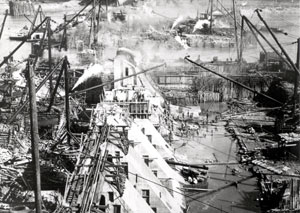
Hales Bar Dam
Hales Bar Dam has the distinction of being the first main-river, multipurpose dam built on the Tennessee River. In order to improve navigation on the Upper Tennessee and provide electricity to the city of Chattanooga, Jo Conn Guild Sr., a Chattanooga engineer, promoted the construction of a privately funded lock and dam which would be turned over to government management in return for the hydroelectric output for a specified period. Congress passed such an act, and the Chattanooga and Tennessee River Power Company began construction on the Hales Bar Dam in October 1905.
The construction of the dam and powerhouse was the largest development of its kind in the region. The dam itself measured almost one-half mile across and sixty-three feet high. The project employed over five thousand men, requiring the construction of a small village to feed and house the workers. Completion of Hales Bar, originally scheduled for 1907, was delayed by flooding and problems with the limestone foundation, and the project was not completed until 1913. The Tennessee Valley Authority (TVA) acquired Hales Bar Dam in August 1939 as part of the Tennessee Electric Power Company purchase. Unable to overcome the foundation and leakage problems, the TVA demolished Hales Bar in 1968 and replaced it with Nickajack Dam, 6.4 miles downstream.



